Key takeaways:
- Engaging audiences effectively involves asking questions, storytelling, and creating a comfortable environment for interaction.
- Identifying your target audience through demographics, interests, pain points, and feedback is essential for tailoring engagement strategies.
- Utilizing interactive elements like Q&A sessions, polls, and gamification enhances audience involvement and helps adapt content based on their preferences.

Understanding Audience Engagement Strategies
When I think about audience engagement strategies, I’m reminded of the times I’ve felt truly connected during a presentation or webinar. It’s often those moments when the speaker asks a simple question, inviting me to reflect and respond. Have you ever noticed how a well-placed question transforms passive listening into an active conversation? It’s a powerful technique that really draws an audience in.
Another approach I’ve found effective is storytelling. I vividly remember a workshop where the speaker shared a personal journey filled with struggles and triumphs. It resonated with me on a deeper level than any statistic or slide ever could. Isn’t it fascinating how we’ve all experienced ups and downs? Sharing relatable stories invites our audience to connect emotionally, fostering an authentic bond that statistics alone can’t create.
Engaging an audience can also come down to the environment we create. I’ve participated in sessions where the layout encouraged interaction, such as small group discussions or brainstorm sessions. It made me feel heard and valued. Have you ever been in a room where everyone felt comfortable sharing? Creating that atmosphere can significantly enhance engagement and foster a collaborative spirit among participants.
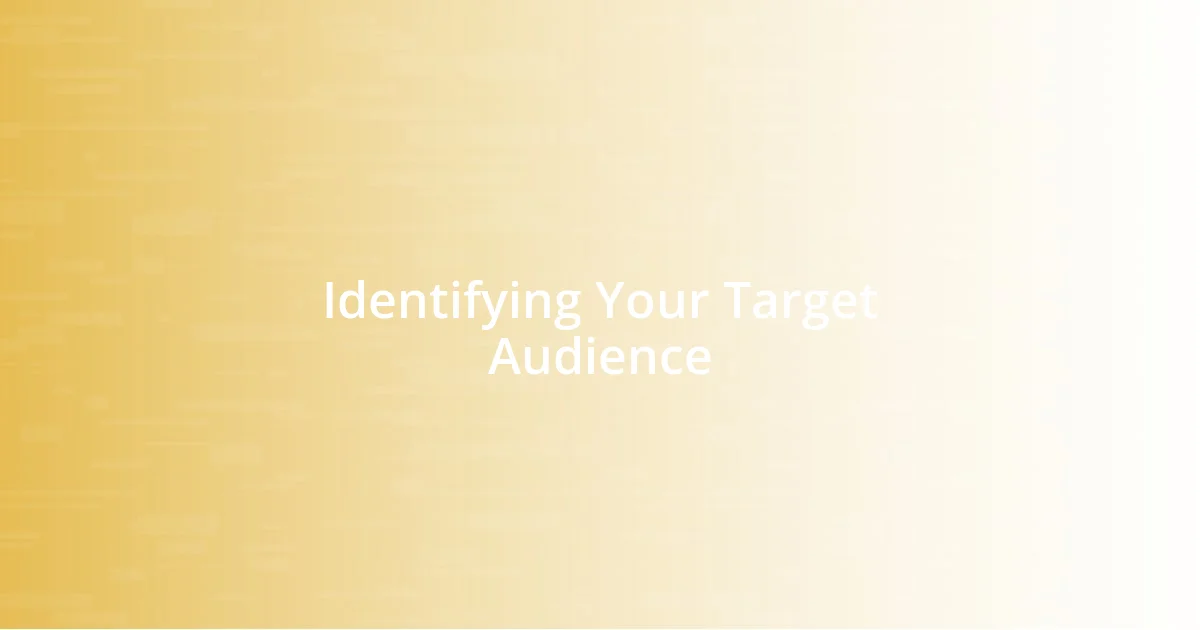
Identifying Your Target Audience
Identifying your target audience is like setting the stage for a compelling performance. It’s all about knowing who you’re engaging with. I remember a time when I misjudged my audience, presenting a topic that I thought everyone would love, only to realize I was speaking to a crowd that craved something completely different. That experience taught me the importance of thorough audience research and understanding their needs before planning any engagement strategy.
To help identify your target audience effectively, consider these key aspects:
- Demographics: Age, gender, location, education level, and occupation can shape interests and preferences.
- Interests and Values: Understanding what truly matters to your audience can guide your content.
- Pain Points: Identifying challenges your audience faces allows for more relevant engagement.
- Preferred Platforms: Knowing where your audience spends their time online or offline helps in selecting the right channels to engage them.
- Feedback Mechanisms: Encourage audience feedback to refine your approach continuously; it’s invaluable for adapting your strategy.
Embracing these components not only boosts your confidence in connecting with others but also acts as a compass in navigating the vast landscape of audience engagement.

Crafting Compelling Content
Crafting content that truly resonates requires both creativity and an understanding of your audience’s needs. I recall a time when I tailored a blog post specifically for hobbyists in a certain niche; the feedback was overwhelming. By focusing on their unique passions, I not only grabbed their attention but inspired them to share the content widely. Wouldn’t you agree that when content sparks enthusiasm, it’s more likely to be noticed?
Moreover, utilizing varied formats can significantly enhance engagement. I’ve had great success combining visuals, such as infographics or short videos, with traditional text. When I introduced a visually rich case study in my presentations, the audience’s eyes lit up. It highlighted critical information without overwhelming them with dense paragraphs. This blend not only caters to different learning styles but also keeps the content dynamic and engaging.
It’s essential to keep the conversation ongoing. I make it a habit to invite feedback after sharing new content. After one particular workshop, a participant suggested incorporating more interactive polls. That simple recommendation led me to experiment with real-time feedback tools; it was a game-changer for audience involvement. How often do we take the time to listen to our audience’s thoughts, even after the content is delivered?
| Approach | Description |
|---|---|
| Understanding Audience Needs | Tailoring content to specific interests improves connection. |
| Diverse Formats | Combining text with visuals can cater to varying learning styles. |
| Inviting Feedback | Encouraging audience input enhances future engagement efforts. |
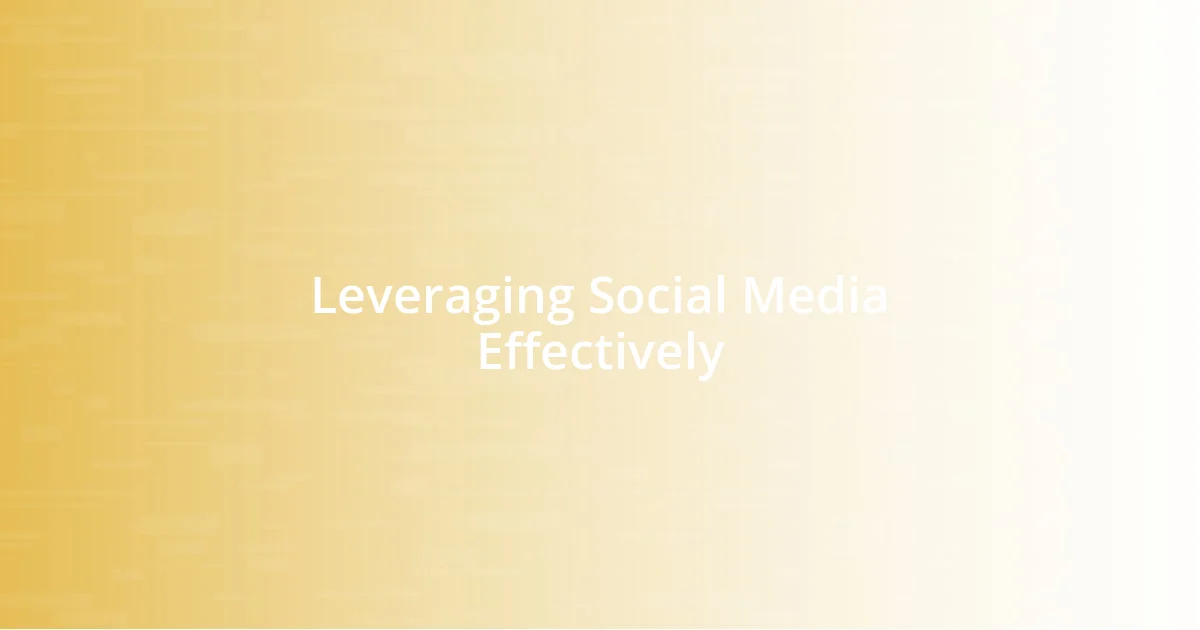
Leveraging Social Media Effectively
Utilizing social media effectively is like hosting a virtual gathering where every post invites a conversation. I vividly remember launching a campaign on Instagram that encouraged followers to share their stories. The outpouring of personal experiences not only fostered community but also made me realize how powerful authenticity is. Have you ever noticed how social media can amplify your message when you let your audience contribute?
While it’s tempting to stick to a rigid posting schedule, I’ve found that spontaneity often leads to the most engaging interactions. For instance, I once shared a behind-the-scenes look at a project I was working on. The candidness resonated so well that it sparked a lively discussion, with followers sharing their own experiences and questions. It’s a reminder that being genuine not only invites engagement but also builds trust.
Finally, paying attention to analytics can significantly enhance your social media strategy. I learned this the hard way after a post that I thought would perform well fell flat. Digging into the metrics helped me discover that my audience preferred lighter, humor-infused content instead. By adjusting my approach based on insights, I’ve been able to connect with my followers on a deeper level. Isn’t it fascinating how data can inform the way we communicate?
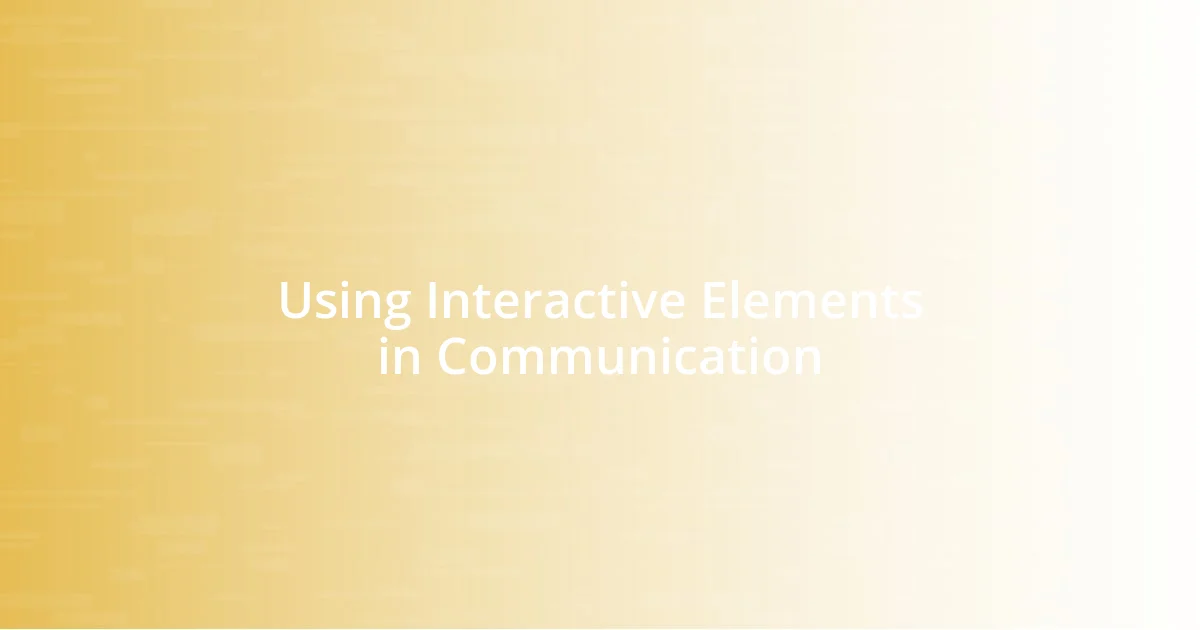
Using Interactive Elements in Communication
One of the most effective methods I’ve discovered in using interactive elements is through live Q&A sessions. When I first tried this, I was amazed at how much curiosity my audience had. Engaging with them in real-time not only fostered a connection, but I also found that their questions often steered the conversation in unexpected and enlightening directions. Have you ever experienced that rush of energy when the audience participates directly? It’s electric!
Polls and quizzes are other interactive tools that can add a touch of fun and engagement to communication. I remember running a quick poll during a webinar, asking participants what topics they wanted to explore further. The instant feedback allowed me to pivot my presentation on the fly, resulting in a much more tailored experience. It was gratifying to see how my audience’s preferences influenced the direction of the session. Don’t you find it rewarding when the content truly reflects the desires of your viewers?
Lastly, gamification has emerged as a brilliant way to captivate audiences. I once incorporated a points system into a workshop where participants earned rewards for asking questions and sharing insights. The competitive spirit ignited enthusiasm and participation; people who might have usually remained quiet suddenly became vocal contributors. Isn’t it interesting how something as simple as friendly competition can transform the dynamics of an event? I confidently believe that planting these interactive elements into our communication strategy enriches the entire experience for everyone involved.
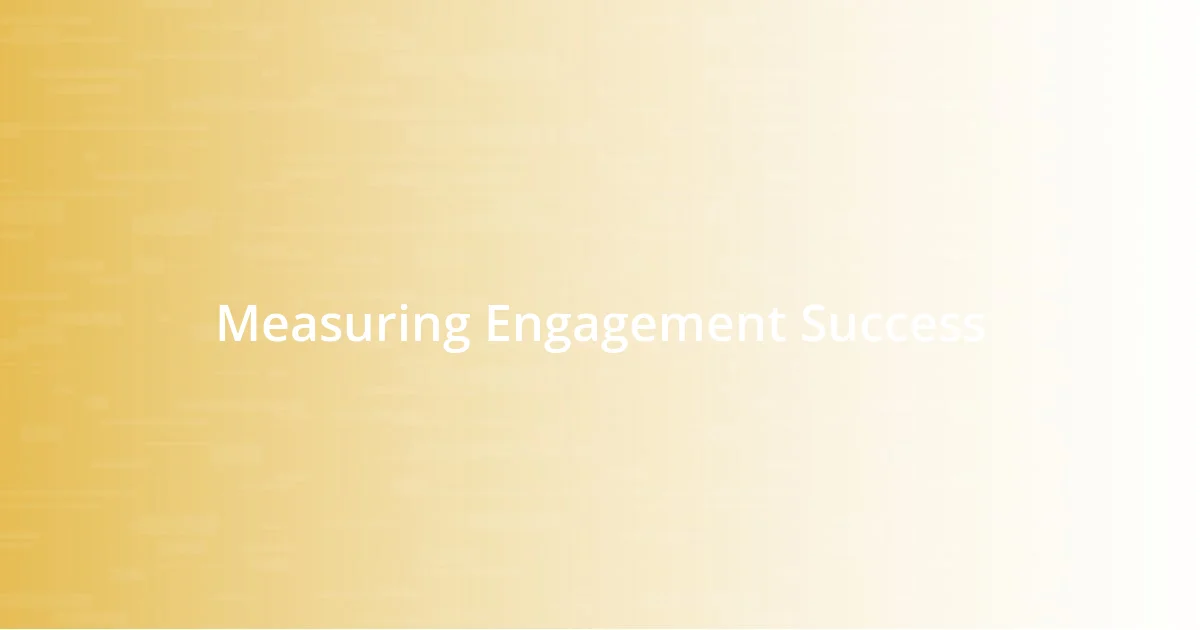
Measuring Engagement Success
Measuring the success of audience engagement is more than just a numbers game; it’s about understanding the story behind those numbers. I remember a time when I launched a survey to gauge how my audience felt about a recent event. The feedback was eye-opening and not just in terms of high scores; it highlighted areas of improvement I hadn’t even considered. Doesn’t it make you wonder how much insight we can gain simply by asking the right questions?
One key metric I always pay attention to is the engagement rate, which combines likes, shares, comments, and participation. Early in my journey, I focused solely on follower counts, thinking that was the ultimate success. But the moment I shifted my focus to how actively people were engaging with my content, everything changed. I found that a smaller audience with high engagement was far more valuable than a larger one that barely interacted. Have you ever thought about the difference between quantity and quality in your own audience?
Lastly, I’ve discovered that qualitative data can be just as important as the quantitative ones. An anecdote that stands out for me is when a follower reached out to share how one of my posts inspired them to take action in their own life. That personal connection was priceless, far exceeding any metrics I could track. Isn’t it incredible how a single meaningful interaction can validate our efforts and inspire us to connect even more? Recognizing both hard data and heartfelt connections is essential in measuring engagement success.
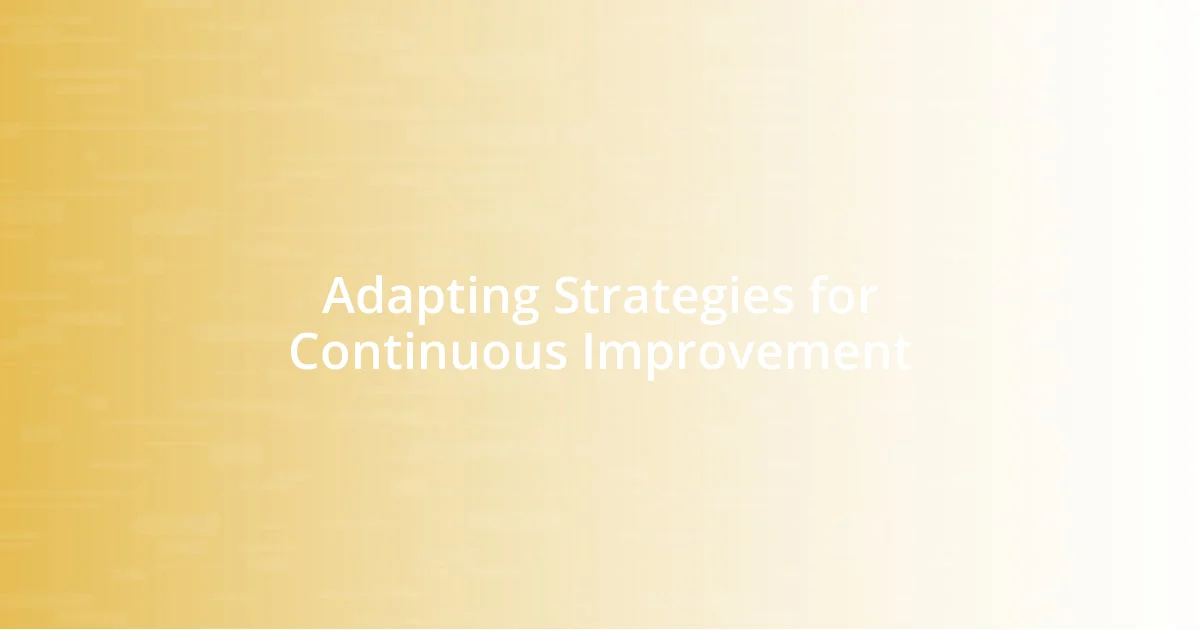
Adapting Strategies for Continuous Improvement
Adapting my engagement strategies has been a revelation throughout my journey. Recently, I implemented a trial-and-error approach to determine which interactive elements resonated most with my audience. For example, after a few workshops, I noticed that activities like breakout sessions drew more interest than I initially anticipated. Have you ever adjusted to what you learn in real-time? It’s fascinating how flexibility leads to more energetic and fruitful exchanges.
One memorable instance was when I decided to modify my content delivery based on audience feedback. During a series of sessions, a participant expressed a desire for more storytelling elements. That suggestion shifted my entire approach, and I’ve since integrated personal anecdotes into my presentations. The result? A visible shift in engagement, as people not only listened but connected emotionally with the narratives. Don’t you realize how small adjustments can create a wave of enthusiasm?
Moreover, I’ve found that regularly revisiting and refreshing strategies keeps my approach relevant. I now schedule monthly reviews of my engagement tactics, ensuring they evolve with my audience’s changing needs. This adaptability has allowed me to experiment with new tools and techniques that, at first, seemed a bit daunting. Remember that feeling of stepping out of your comfort zone? Embracing change, while sometimes challenging, has led to richer conversations and deeper connections.















